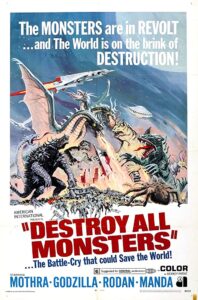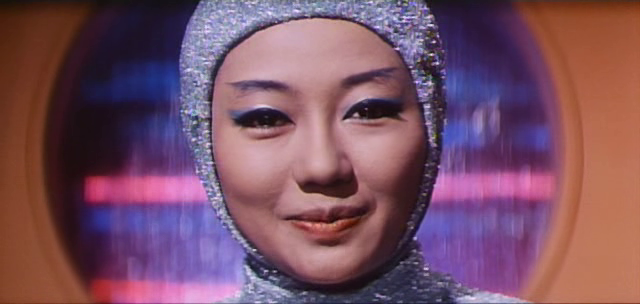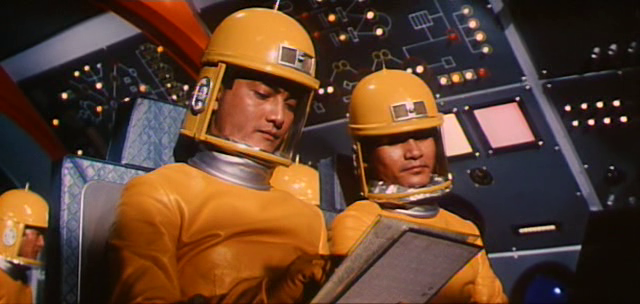“Unless we agree to these terms, the monsters will destroy all of us… Why, this is just like — blackmail!”
|

Synopsis:
In futuristic Japan, an astronaut (Akira Kubo) on the moon contacts a scientist (Yukiko Kobayashi) in “Monsterland” — an island where all the world’s giant monsters co-exist safely — just as a toxic gas covers the island. The astronauts soon learn that the monsters have been set loose to attack various big cities, and the scientists have been brainwashed by a race of female aliens determined to take over the world. Can their civilization be saved?
|
|
Genres, Themes, Actors, and Directors:
- Aliens
- Japanese Films
- Mutant Monsters
- Science Fiction
- Space Opera
- World Domination
Review:
This Toho Studios productions brings together all the monsters it can possibly find from previous films — including Godzilla, King of the Monsters! (1956), Rodan (1957), and Mothra (1962), and more — into an epic futuristic battle against world-dominating aliens. It’s earnest as all get out, with hilarious dubbing (at least in the version I saw), colorful sets and costumes, diabolical mind control, and plenty of monster-fight action. As noted in Spinning Image’s review, it makes for “entertainingly ridiculous enjoyment, all performed with a straight face and commendable vigour”. With that said, it’s not must-see for all film fanatics — simply those who appreciate the unique joys of this particular genre.
Redeeming Qualities and Moments:
- Colorful cinematography, costumes, and sets


- The exciting monster fight-out at the end


- Laughable (dubbed) dialogue: “Is it a failure then? Are we all… doomed?”
Must See?
No, but it’s recommended for its sheer cult enthusiasm. Listed as a Camp Classic in the back of Peary’s book.
Links:
|





2 thoughts on “Destroy All Monsters (1968)”
You should always watch the Godzilla films, indeed all of Toho’s popular entertainments in the original Japanese language versions.
Because they’re populist family entertainments there was no market for them in Japanese and thus they were badly dubbed and considered disposable trash.
They’re certainly cheesy with the exception of the 1954 original which is superb and up there with King Kong (1933) as one of the great monster films, but they’re steeped in Japanese cultural imperatives, bias and approaches. Utter realism in the SPFX isn’t as important as the symbolism and the craft.
Not must-see – but it will be of interest to those with a fondness for Japanese monster movies.
It certainly has its share of unintentionally funny dialogue:
“There are countless asteroids between Mars and Jupiter. She’s from one of them.”
“You believe that?”
“What I believe isn’t important. I admire their scientific knowledge and creativity.”
(Doctor removes a small, round piece of metal from *inside* a man’s neck.)
“Was he hard-of-hearing?”
” No.”
“Then this isn’t a hearing aid.”
For this viewing, I watched the subtitled Criterion (!) version so, for what it’s worth, it looked great (even the toy tanks, the toy land rovers, the toy space ships… all the toy stuff; there’s a lot of toy stuff).
The various scenes of destruction are fairly giggle-worthy. The climactic battle sequences are both earnest and spectacular(ly silly)!